Sheila Delany’s
Electronic Office

For reprinted items, see the “Reprints” section following this section.
Click here to view: Books Articles, etc Poetry Reprints
Books
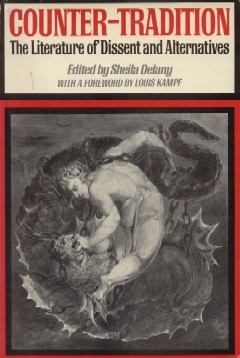
Edited with introduction and notes by S.D.
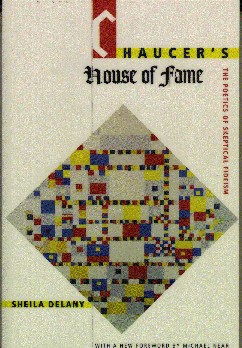
Writing woman: Women writers and women in literature, medieval to modern. New York: Schocken, 1983; reprinted 2007, see below and q.v.
Collection of essays by S.D.
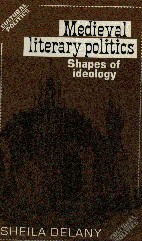
Collection of essays by S.D.
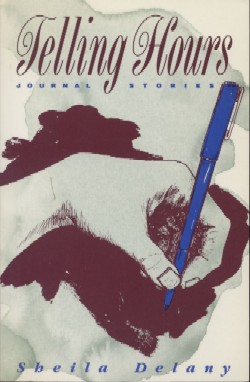
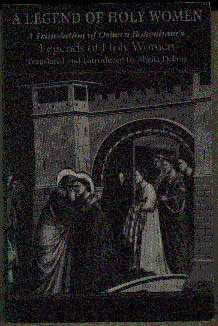
A late Middle English text by Osbern Bokenham, translated with introduction and notes by S.D.
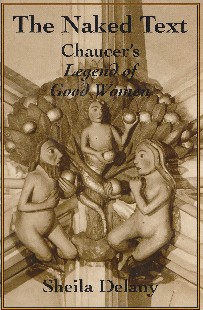
reprinted 2021, in the University of California’s Voices Revived series, “which commemorates UC Press’s mission to seek out and cultivate the brightest minds and give them voice, reach, and impact” (University of California Press), q.v.
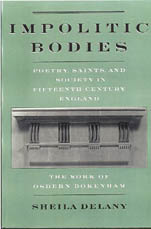
This book won the first Labarge prize for best book in medieval studies, awarded by the Canadian Society of Medievalists in 1999.
“Turn it again”: Medieval Jewish studies and literary theory. special issue of Exemplaria 12 (2000). Edited with introduction by S.D. See below.
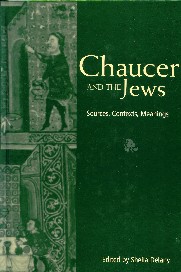
Edited by S.D.
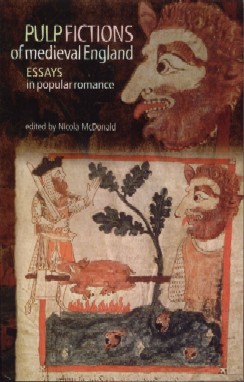
Edited by Nicola McDonald. Chapter: “A, A, and B: Coding same-sex union in Amis and Amiloun” by S. D.
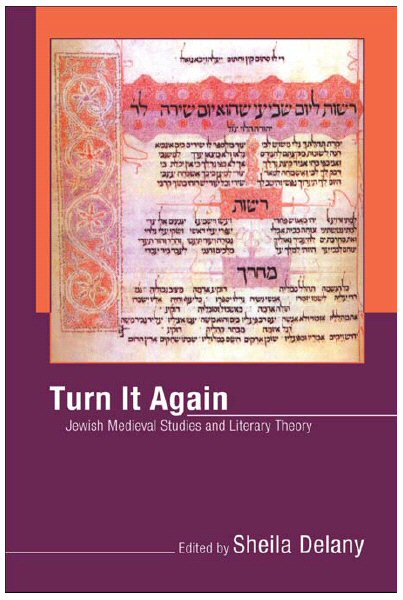
Edited by S.D.
Robert A. Daum, Diamond Chair in Jewish Law and Ethics, University of British Columbia
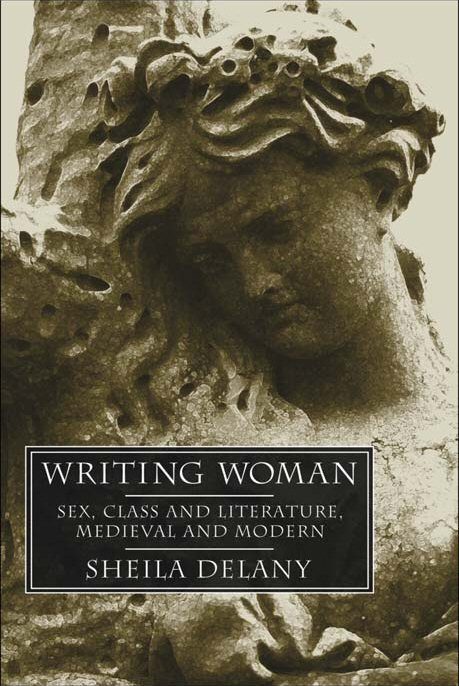
Collection of essays by S.D.
Booklist
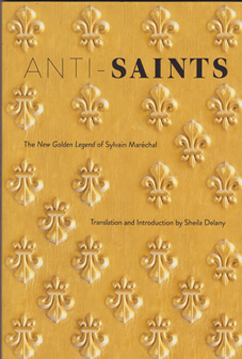
Translation, introduction, and notes by S.D.
David Gay, Professor of English, University of Alberta
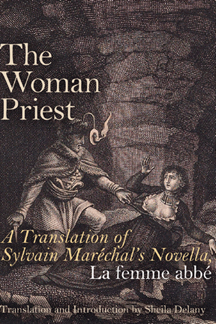
Translation, introduction, and notes by S.D.
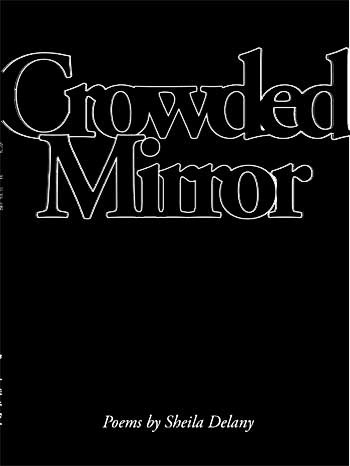
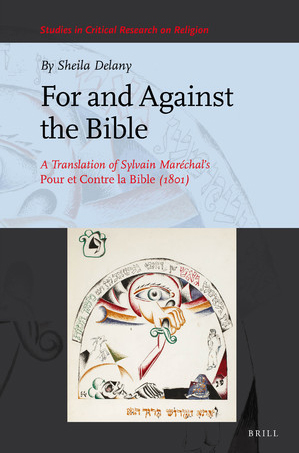
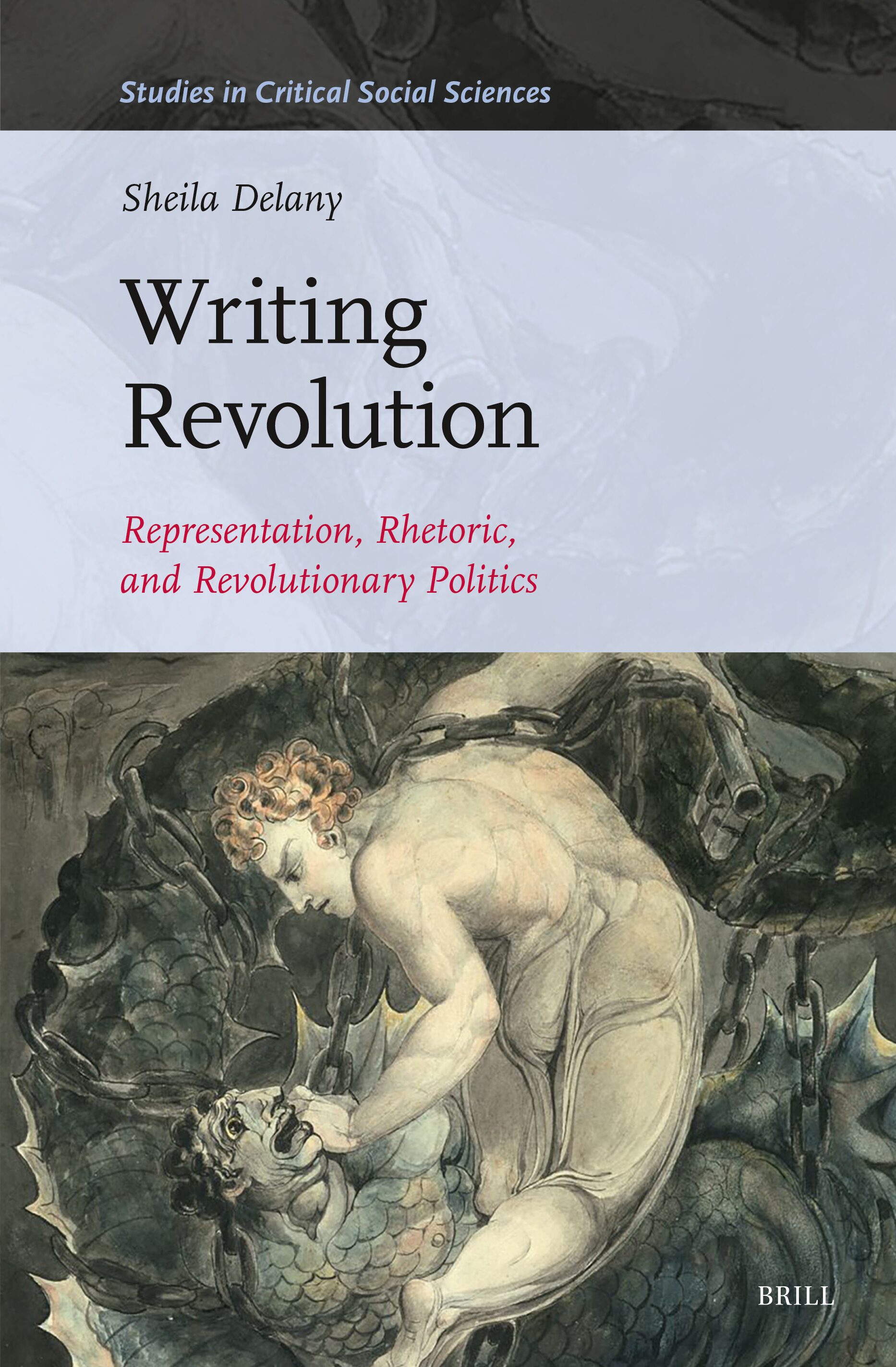
back to top
Articles, Essays, Reviews, Stories, Conference Papers:
“Melville in the Darbies,” Keynote (Wellesley College, Spring 1960): 33–39.
“Tell me another funny one” (story), Keynote (Wellesley College, Winter 1961): 20–25.
“On Salinger,” Berkeley Graduate Journal (Spring 1963): 23–24.
“Clerks and quiting in The Reeve’s tale,” Mediaeval Studies 29 (1967): 351–56.
“Phantom and The house of fame,” Chaucer Review 2.2 (1967): 67–74.
“Chaucer’s House of fame and the Ovide moralisé,” Comparative Literature 20.3 (1968): 254–64. Reprinted 1999, q.v.
“Operation SEEK: Down from liberalism,” NUC Newsletter (May 1970): 21–24.
“Up against the Great Tradition,” in The politics of literature: Dissenting essays on the teaching of English, ed. Louis Kampf and Paul Lauter, 308–21 (New York: Pantheon, 1970; New York: Vintage, 1973).
“King Hart: Rhetoric and meaning in a Middle Scots allegory,” Neophilologus 55 (1971): 329–41.
“Racist sci-fi,” review of Chariots of the gods? Unsolved mysteries of the past, by Erich von Däniken, Canadian Dimension 9 (March 1972): 47–48.
Review of The visionary landscape: A study in medieval allegory, by Paul Piehler, West Coast Review 6 (1972): 79–81.
“Undoing substantial connection: The late-medieval attack on analogical thought,” Mosaic 5 (Summer 1972): 31–52. Reprinted 1972, q.v.
“‘Ars simia naturae’ and Chaucer’s House of fame,” English Language Notes 11.1 (1973): 1–5.
“Substructure and superstructure: The politics of allegory in the fourteenth century,” paper presented at UBC Medieval Workshop, 1973. Longer version published in Science & Society (1974), q.v.
“Political style/Political stylistics,” Style 8 (1974): 437–51.
Review of Marxism and art: Essays classic and contemporary, ed. Maynard Solomon, West Coast Review 9 (1974) 70–72.
“Substructure and superstructure: The politics of allegory in the fourteenth century,” Science & Society 38 (1974): 257–80.
“Theocratic and contractual kingship in Havelok the Dane,” Zeitschrift für Anglistik und Amerikanistik 22 (1974): 290–302. Reprinted 1974, q.v.
“Womanliness in The Man of Law’s tale,” Chaucer Review 9.1 (1974): 63–72. Reprinted in Writing woman (1983), q.v.
“Marxism, art and social reality,” review of Marxism and art: Writings in aesthetics and criticism, by Berel Lang and Forrest Williams; and The philosophy of art of Karl Marx, by Mikhail Lifshitz, Canadian Dimension 10 (1975): 47–50.
“Red Rosa: Bread and roses,” Massachusetts Review 16 (1975): 373–86.
“Sex and politics in Pope’s Rape of the lock,” English Studies in Canada 1 (1975): 46–61. Reprinted in 1976 and in Writing woman (1983), q.v.
“Sexual economics, Chaucer’s Wife of Bath, and The book of Margery Kempe,” paper presented at UBC Medieval Workshop, 1975. Published in Minnesota Review (1975), n.s., 5 (1975): 104–15. Reprinted in Writing woman (1983) and in 1994, q.v.
“Techniques of alienation in Troilus and Criseyde,” in The uses of criticism, ed. A.P. Foulkes, 77–95. Bern & Frankfurt: Lang, 1976. Reprinted 1992 and 2005, q.v.
“Florus and Jehane: The figure of the bourgeois woman in medieval life and letters,” paper presented at MAP conference, 1978. Published in Science & Society (1981), q.v.
Review of The Order of the Rose: The life and times of Christine de Pizan, by Enid McLeod, Signs 3.3 (1978): 700–01.
“A response to Bell & Diamond,” Signs 4.3 (1979): 596.
“Politics and the paralysis of imagination in The Physician’s tale,” paper presented at MAP conference, 1980. Published in Studies in the Age of Chaucer (1981), q.v.
Review of In our own house: Social perspectives on Canadian literature, ed. Paul Cappon, English Studies in Canada 6 (1980–81): 517–25.
“Florus and Jehane: The figure of the bourgeois woman in medieval life and letters,” Science & Society 45.3 (1981): 274–87. Reprinted in Writing woman (1983), q.v.
“The politics of comic theory: Bergson, Meredith, Bakhtin,” paper presented at UBC conference on “Literature and Ideology,” 1981.
“Politics and the paralysis of imagination in The Physician’s tale,” Studies in the Age of Chaucer 3 (1981): 47–60.
“Confessions of an ex-handkerchief head, or why I am not a feminist,” Queen’s Quarterly 89.4 (1982): 816–28. Reprinted in Writing woman (1983), q.v.
Review of Revolution as tragedy, by John P. Farrell; Tragic realism and modern society, by John Orr; and The politics of landscape: Rural scenery and society in English poetry, 1630–1660, by James G. Turner, Style 16.1 (1982): 82–87.
“Rewriting woman good: Gender and the anxiety of influence in two late-medieval texts,” paper presented at “Chaucer at Albany” international conference in honor of R. H. Robbins, 1982; at NEMLA 1985; and at MAP 1986. Published in Chaucer in the eighties, ed. Julian Wasserman and Robert J. Blanch (1986), q.v.
“My mother’s feet” (essay-story), Ms. Magazine (May 1983): 98–102.
“Our heroine was no democrat,” review of Cité des dames, by Christine de Pizan, trans. E. J. Richards, Radical Reviewer 9 (June 1983): 20–21.
“A subject for poetry,” review of Inside job: Essays on the New Work writing, by Tom Wayman, Literary Storefront Newsletter (July 1983); Canadian Forum 63 (November 1983).
“The conservatism of Christine de Pizan,” paper presented at MLA Convention, New York, 1983.
“Doer of the word: The epistle of St. James as a source for Chaucer’s Manciple’s tale,” Chaucer Review 17.3 (1983): 250–54.
“‘Mothers to think back through’: Who are they? The ambiguous example of Christine de Pizan.” invited paper presented at “Facets of Feminist Criticism” conference sponsored by English Institute at McMaster University, 1983. Published in Medieval texts and contemporary readers, ed. Laurie A. Finke and Martin B. Schichtman (1987), q.v.
“The arch-criminal” (story), Fiddlehead 140 (1984).
“At the pool” (story), The Capilano Review 30 (1984). Reprinted in 1985, q.v.
“Beginning” (story), The Capilano Review 30 (1984).
“Ferragosto” (story), West Coast Review 18 (1984). Reprinted in 1985, q.v.
“In the canyon” (story), Grain 13 (1985). Nominated for the National Magazine Award.
“King of the block” (essay-story), Queen’s Quarterly 91 (1984). Reprinted in 1985, q.v.
“The logic of obscenity in The legend of good women,” paper presented at New Chaucer Society biennial congress, 1984; as lecture at University of Washington Medieval Seminar 1984, and at PAPC, 1984. Published in Florilegium (1987), q.v.
“Marriage and misogyny in The Manciple’s tale,” paper presented at MAP conference, 1984.
“‘Mulier est hominis confusio’: The anti-popular Nun’s Priest’s tale,” special issue of Mosaic 17 (1984): 1–8.
“Rewriting Christine,” review of Cité des dames, by Christine de Pizan, trans. E. J. Richards, Women’s Studies 10 (1984): 339–42.
“The unveiling” (story), Fiddlehead 140 (1984).
“Journals and fiction,” Queen’s Quarterly 92 (1985): 457–64.
“Party girl” (story), runner-up in Stand Magazine (Britain) international competition (1985).
“Rewriting woman good: Gender and the anxiety of influence in two late-medieval texts,” Chaucer in the eighties, ed. Julian Wasserman and Robert J. Blanch, 75–92 (Syracuse, NY: Syracuse University Press, 1986).
“Run silent, run deep.: Heresy and alchemy as alternatives to utopian discourse in the Middle Ages,” paper presented at SFU Medieval Symposium (1985); and as invited plenary paper at ANZAMRS conference, Melbourne, Australia, 1986. Reprinted in Medieval Literary Politics (1990), q.v.
“Tree day” (story), The Massachusetts Review 26 (1985).
“‘Loi’ and ‘Foi’ in the Man of Law’s introduction, prologue and tale,” Mediaevalia 8 (1986 for 1982): 135–49.
“The reading (a theory of fiction)” (story), Tessera (1986); special issue of Canadian Fiction Magazine 57.
“The politics of the signified in Brecht’s The measures taken,” paper presented at International Conference and Theatre Festival “Brecht: Thirty Years After,” University of Toronto, 1986. Published in Clio (1988 for 1986), q.v.
Telling hours: A convent journal. Excerpts in The Capilano Review 41 (1986).
Review of Dust-ship Glory, by Andreas Schroeder, The Reader (October 1986).
“Women, nature and language in The legend of good women,” paper presented at New Chaucer Society international biennial congress, 1986.
“The cleric and the courtier: Osbern Bokenham’s corrective to Geoffrey Chaucer,” paper presented at MLA Convention, San Francisco, CA, 1987.
“A minor operation” (story), dramatized on CBC “Art Beat,” October 1987. Published in Queen’s Quarterly (1991), q.v.
“The logic of obscenity in The legend of good women,” Florilegium 7 (1987 for 1985): 189–205.
“‘Mothers to think back through’: Who are they? The ambiguous example of Christine de Pizan,” Medieval texts and contemporary readers, ed. Laurie A. Finke and Martin B. Schichtman, 177–197 (Ithaca, NY: Cornell University Press, 1987). Reprinted 1997, q.v.
Review of The worlds of medieval women: Creativity, influence, and imagination, ed. Constance H. Berman, Charles W. Connell, and Judith Rice Rothschild. Studies in the Age of Chaucer 9 (1987): 178–80.
“Two studies of marriage,” review of The marriage bargain: Women and dowries in European history, by Marion Kaplan, and Marriage and love in England, 1300–1840, by Alan MacFarlane, Science & Society 51 (1987): 206–10.
“Anatomy of the resisting reader. Implications of resistance to sexual wordplay in medieval poetry,” invited paper for New Chaucer society biennial congress, 1988. Expanded version presented as invited lectures at Rutgers University and Columbia University, 1989. Published in Exemplaria (1992), q.v.
“Geoffrey of Monmouth and Chaucer’s Legend of good women,” Chaucer Review 22.2 (1988): 17–24.
“Notes on experience, authority, and desire in the Wife of Bath’s recital,” Hebrew University Studies in Literature and the Arts 15 (1988 for 1987): 27–35.
“The politics of the signified in Brecht’s The measures taken,” Clio 16 (1988 for 1986): 67–80.
Review of Chaucer, by David Aers, and Geoffrey Chaucer, by Stephen Knight, Science & Society 52 (1988): 239–41.
Review of Chaucer: His life, his works, his world, by Donald R. Howard, Medieval Feminist Newsletter 6 (1988): 13.
Review of Women’s liberation and the dialectics of revolution, by Raya Dunayevskaya, Labour/Le travail 21 (1988): 310–11.
“The naked text: Chaucer’s ‘Thisbe,’ the moralisé, and the problem of Translatio studii,” paper presented at Binghamton Center for Medieval Studies, New York, 1986. Published in Mediaevalia (1989 for 1987), q.v.
“Strategies of silence in the Wife of Bath’s recital,” invited contribution to “Reconceiving Chaucer” conference, Rochester, NY, 1988. Published in Exemplaria (1990), q.v.
“Impolitic bodies: A proto-feminist hagiography of the fifteenth century," various versions presented as invited lectures at Delaware Valley Medieval Association, MAP, University of London, and Cambridge University, 1989; University of Amsterdam, 1990.
“A horde of butterflies” (story), The Capilano Review 50 (1989), special invitational issue. Shortlisted for Prism prize, 1991.
“The naked text: Chaucer’s ‘Thisbe,’ the moralisé, and the problem of Translatio studii,” Ovid in Medieval Culture, special issue of Mediaevalia 13 (1989 for 1987): 275–94.
“Difference and the difference it makes: History, politics and the gender-conscious medievalist.” Invited paper presented at “Medieval Women” conference at University of York, England, 1990; Vancouver Medieval Symposium and SFU English Department symposium, 1990. (Note that despite use of same phrase in part of title, this is a different paper from the one just below.)
“Difference and the difference it makes: Sex and gender in Chaucer’s poetry,” invited paper presented at “A Wyf Ther Was” conference in Liège and at Universities of Utrecht, Nijmwegen and Leiden, 1990. Revised version presented at Humanities Institute conference “New Studies in the Middle Ages” in Claremont, CA, 1991; as an invited keynote address at the Ottawa-Carleton annual medieval symposium, 1991; and at Baruch College, CUNY, 1991; presented at several South African universities in 1994. Published in Florilegium and Liège Language and Literature (both 1992), q.v.
Review of Community, gender and individual identity: English writing, 1360–1430, by David Aers, Studies in the Age of Chaucer 12 (1990): 239–42.
Review of Medieval popular culture: Problems of belief and perception, by Aron Gurevich, trans. János M. Bak and Paul A. Hollingsworth. Science & Society 54 (1990): 244–46.
Review of Through nature to eternity: Chaucer’s “Legend of good women”, by Donald W. Rowe. Modern Language Quarterly 49 (1990 for 1988): 73–76.
“Strategies of silence in the Wife of Bath’s recital,” special issue, Exemplaria 2.1 (1990): 49–69.
“Difference and the difference it makes: Sex and gender in Chaucer’s poetry,” Florilegium 10 (1988–1991): 83–92. Reprinted 1992, q.v.
“A minor operation” (story), Queen’s Quarterly 98 (1991): 911–17.
Review of A Comedy of betrothal (Carleton Renaissance Drama Text), by Leone de' Sommi Ebreo, trans. Alfred S. Golding, Outlook 29.9 (September 1991): 26.
“The somaticized text: Osbern Bokenham’s Legendary,” paper presented at MLA Convention, San Francisco, CA, 1991.
“‘This borrowed language’: Body politic in Judges 19–21,” paper presented at annual Woodsworth conference at SFU, 1991, and as talk at Green College, UBC, Spring 1997. Published in Shofar (1993), q.v.
“Anatomy of the resisting reader: Some implications of resistance to sexual wordplay in medieval literature,” invited contribution to special issue of Exemplaria 4.1 (1992): 7–34.
“Chaucer’s Legend of good women: The relevance of Wyclif,” paper presented at New Chaucer Society (Seattle), 1992.
“Geographies of desire: Orientalism in the Legend of good women,” inaugural issue, Chaucer Yearbook: A Journal of Late Medieval Studies 1 (1992): 1–32. Invited contribution. Shorter version presented as talk at SFU English Department Symposium, 1991. Reprinted 2002, q.v.
“History, politics and Christine studies: A polemical reply.” Politics, gender, and genre: The political thought of Christine de Pizan, ed. Margaret Brabant, 193–206 (Boulder, CO: Westview, 1992). Invited contribution.
“On bell hooks,” review of bell hooks’s lecture “Race, gender, and representation” (Robson Centre, Vancouver, BC, February 6, 1992), Vancouver Review 8 (March 1992): 12.
Review of Chaucer and the fictions of gender, by Elaine Tuttle Hansen, Modern Language Quarterly 53 (1992): 367–71.
Review of Chaucer’s sexual poetics, by Carolyn Dinshaw, Women’s Studies 20 (1992): 354–61.
“With crimson in triumph marching” (story), Wascana Review 27:2 (1992): 1–6.
“Alibis” (journal-story), Event 22 (Winter 1993–4): 12–26. This piece won the journal’s Creative Non-Fiction Contest, 1993.
“Commerce With eternity: Language, body and dualism in Bokenham’s Cecelia,” paper presented at joint MAA/MAP meeting, Tucson, AZ, 1993.
“Medieval studies in BC.” Invited paper at inaugural conference of Society of Canadian Medievalists, Ottawa Learneds, 1993.
Review of The allegory of female authority: Christine de Pizan’s “Cité des dames,” by Maureen Quilligan, Studies in the Age of Chaucer 15 (1993): 263–68.
“‘This borrowed language’: Body politic in Judges 19–21,” special issue “Bible as Literature,” Shofar 11 (1993): 97–109.
“Bokenham’s Katherine as Yorkist propaganda,” paper presented at MLA Convention, San Diego, 1994.
Review of Jewish life in renaissance Italy, by Robert Bonfil, trans. Anthony Oldcorn, Outlook 32 (Fall 1994): 19–20.
Review of Same sex unions in pre-modern Europe, by John Boswell, Vancouver Review 15 (Summer 1994): 22.
“What has medieval studies to offer the new South Africa?” Keynote address at SASMARS conference, Pretoria, South Africa, 1994; and at several South African universities. Also presented at Humanities Institute at SFU, August 1994.
Review of The Jews of Moslem Spain, by Eliyahu Ashtor, trans. Aaron Klein and Jenny Machlowitz Klein, Outlook 33 (April 1995).
“Afterlife of a medieval genre: Maréchal’s ‘revolutionary’ legendary,” Friends of the Saints (New York, 1995).
“Bokenham’s Claudian as Yorkist propaganda,” paper presented at International Society for the Classical Tradition, Boston, MA, 1995. Published in Journal of Medieval History (1996), q.v.
“Chaucer’s orientalism in the Legend,” paper presented at the New York Medieval Club conference, 1995; also respondent to another paper on medieval multiculturalism and teaching.
“The Friar as critic: Bokenham reads Chaucer,” invited paper at biennial Bennett Memorial Symposium, Perugia, Italy, 1995. Published in Medievalitas: Reading the Middle Ages, ed. Piero Boitani and Anna Torti (1996), q.v.
“Hagio, porn, and femcrit.” Invited plenary for ACCUTE at Montreal Learneds, 1995.
“The somaticized text: Corporeal semiotic in a late medieval female hagiography,” paper presented at University of Rochester faculty and graduate symposium, 1995. Published in Textual bodies: Changing boundaries of literary representation, ed. Lori Lefkowitz (1997), q.v.
“Afterlife of a medieval genre: The all-female legendary and modern politics,” invited plenary for CSM at St. Catherine’s Learneds, 1996; also presented as keynote at Montana Medieval Round-up, Fall 1996.
Review of On the demon-mania of witches, by Jean Bodin, ed. Jonathan L. Pearl, trans. Randy A. Scott, University of Toronto Quarterly 66.1 (Winter 1996–97): 326–27.
“Bokenham’s Claudian as Yorkist propaganda,” Journal of Medieval History 22 (1996): 83–96.
“The Friar as critic: Bokenham reads Chaucer,” Medievalitas: Reading the Middle Ages, ed. Piero Boitani and Anna Torti, 63–79. Cambridge: Brewer, 1996.
“The Prioress, the Jews, and the Muslims,” paper presented at R. Hanning’s medieval group in New York, 1996; at UBC Medieval Symposium on “Islam in Medieval Europe,” 1997; and as the annual Rossell Hope Robbins lecture for NY Medieval Club, 1998. Published in Medieval Encounters 5 (1999), q.v.
Review of Male authors, female readers, by Ann Clark Bartlett, Speculum 72.4 (1997): 1146–47.
“The somaticized text: Corporeal semiotic in a late-medieval female hagiography,” in Textual bodies: Changing boundaries of literary representation, ed. Lori Lefkowitz, 101–25. Albany, NY: SUNY, 1997.
“Violence in art” and “‘This borrowed language,’” two invited talks at Green College, UBC, Spring 1997.
“Historicizing the Prioress: Life and art in a Chaucerian narrative,” invited paper presented at Hebrew University, Jerusalem (May 1998).
“Matronage or patronage? The case of Osbern Bokenham’s women patrons,” invited paper presented at Leeds International Medieval Congress (July 1998). Expanded version published in Florilegium (1999), q.v.
“The Jewish connection: Historicizing the Prioress,” paper presented at Green College, UBC (October 1998).
“Feminist criticism and Chaucer studies,” New Chaucer Society, Paris, 1998. Panelist.
“Bokenham, Osbern (1392/93–after 1463).” Medieval England: An encyclopedia, ed. Paul Szarmach, M. Teresa Tavormina, and Joel T. Rosenthal, 134–35 (New York: Garland, 1998).
Review of Joe Slovo: The unfinished autobiography, by Joe Slovo; and Every secret thing: My family, my country, by Gillian Slovo, Outlook 36.1 (1998).
Review of The sacred chain: The history of the Jews, by Norman F. Cantor, and Medieval stereotypes and modern anti-semitism, by Robert Chazan, Outlook 36 (1998): 19, 29.
Outlook: Canada’s Progressive Jewish Magazine 36.1, special issue on Black–Jewish relations (1998): 10–23. Guest-edited by S.D.
“Chaucer and the Paris Jews, 1394,” paper presented at Kalamazoo International Medieval Congress (July 1999) and Ben Gurion University of the Negev, Beersheva, Israel (February 2000).
“Chaucer’s Prioress, the Jews, and the Muslims.” Medieval Encounters 5 (1999): 198–213. Reprinted in Chaucer and the Jews (2002) and translated into Spanish, 2006, q.v.
“Matronage or patronage? The case of Osbern Bokenham’s women patrons,” Festschrift for Douglas Wurtele, ed. Jane Toswell, Florilegium 16 (1999): 97–105.
“Millennial? Chaucer?” Invited paper at Chaucer forum panel, MLA Convention, Chicago, December 1999.
Review of Chaucer’s open books: Resistance to closure in medieval discourse, by Rosemary P. McGerr, Arthuriana 9 (1999): 122–123.
Review of Crisis in the Israeli kibbutz, by Uriel Leviatan, Hugh Oliver, and Jack Quarter, Outlook 37 (1999).
Review of Matrons and marginal women in medieval society, by Robert Edwards and Vickie Ziegler, Journal of English and German Philology 96 (1999 for 1997): 251–53.
Review of Medieval women in their communities, ed. Diane Watt, Medievalia et humanistica 26 (1999): 216–18.
“Jews in medieval England,” invited paper at Ben Gurion University, Israel, February 2000.
“Marxist medievalists: A tradition,” panelist on “Oral history of women scholars” panel at Kalamazoo, MI, 2000.
Published in Medieval Feminist Forum 30 (Fall 2000): 9–15. Expanded versions presented in 2002, and published in Studia Anglica Posnaniensia (2003) and as “Marxist medievalists: A tradition,” in Science & Society (2004), q.v.“The Jewish connection: Chaucer and the Paris Jews, 1394,” paper presented at the Association for Jewish Studies in Washington, DC (December 2001) and University of Warsaw (May 2002).
Review of Covert operations: The medieval uses of secrecy, by Karma Lochrie, in Speculum 76 (2001): 489–90.
Review of The Siege of Jerusalem in its physical, literary and social dimensions, by Bonnie Millar, in Speculum 76.4 (2001): 1081–82.
“Marxist medievalists: A tradition,” keynote at a conference honoring Margaret Schlauch (Poznan, Poland) and at Central European University, Budapest, both in May 2002.
“Creation, re-creation and recreation in an Old Yiddish romance: Elias Levita’s Bovo-bukh,” Keynote at South African Society for Medieval and Renaissance Studies, Pretoria, September 2002; also presented at Peretz Centre for Secular Jewish Culture and in SFU English Department, Winter 2002. Shorter and different version at Learneds, 2004 (see below).
Review of A companion to Chaucer, by Peter Brown, Speculum 77.3 (2002): 882–84.
Review of The Jewish pope: Myth, diaspora and Yiddish literature, by Joseph Sherman, Mendele Review 7 (December 28, 2003). TMR is a peer-reviewed electronic journal distributed by Yale University, archived at Trinity College, and managed by L. Prager at Haifa University.
“Medieval Marxists: A tradition,” Studia Anglica Posnaniensia 38 (2003): 11–21.
“A, A, and B: Coding same-sex union in Amis and Amiloun,” in Pulp fictions of medieval England: Essays in popular romance, ed. Nicola McDonald, 63–81. Manchester: Manchester University Press, 2004.
“Confluence and resistance in an Old Yiddish romance: Elias Levita’s Bovo-bukh.” paper presented at inaugural session of Canadian Society of Jewish Studies, Winnipeg, 2004.
“Marxist medievalists: A tradition,” Science & Society 68.2 (2004): 206–15.
“Bokenham, Osbern,” Women in the Middle Ages: An encyclopedia, 2 vols., ed. Katharina Wilson and Nadia Margolis, 1:117–19 (Westport, CT: Greenwood, 2004).
Review of Absent narratives, manuscript textuality, and literary structure in late medieval England, by Elizabeth Scala, Speculum 79.1 (2004): 271–73.
“Sex and revolution: Avram Room’s Bed and sofa (1926),” paper presented at the 39th annual Comparative Literature Conference, “Film, ideology and culture,” California State University–Long Beach, 2004.
Review of Fashioning Jewish identity in medieval western Christendom, by Robert Chazan, Speculum 80.1 (2005): 24.
Review of Late-medieval prison writing and the politics of autobiography, by Joanna Summers, Notes & Queries n.s. 52.3 (2005): 394–95.
“Bovo then and now: An Old Yiddish romance in its time and ours,” paper presented at “Meaningful marginalities” conference in religion and culture, University of Alberta, Edmonton, 2006. Expanded version published in Medieval Cultural Studies, ed. Ruth Evans, Helen Fulton, and David Matthews (2006), q.v.
“Bovo then and now: An Old Yiddish romance in its time and ours,” in Medieval Cultural Studies, ed. Ruth Evans, Helen Fulton, and David Matthews, 181–97 (Cardiff: University of Wales Press, 2006).
“Osbern Bokenham,” Oxford encyclopedia of British literature, ed. Gail M. Gibson, 1:224–26 (Oxford: Oxford University Press, 2006).
Review of Gender and Jewish difference from Paul to Shakespeare by Lisa Lampert, and Mothers and children. Jewish family life in medieval Europe, by Elisheva Baumgarten, Speculum 81.2 (2006): 551–53.
Review of Medieval women’s writing: 1100–1500, by Diane Watt, Journal of English and Germanic Philology (July 2009): 406–08.
“Getting anecdotal,” Medieval feminist forum 45 (2009): 114–19.
“Afterlife of a medieval genre: La nouvelle lé:gende dorée (1790) of Sylvain Maréchal,” special issue of Exemplaria 22 (2010): 28–43. Invited contribution.
“Chaucer and the Paris Jews, 1394,” in Locating the past, discovering the present: Perspectives on religion, culture and marginality, ed. David Gay and Stephen Reimer, 1–21 (Edmonton: University of Alberta Press, 2010).
“Bible, Jews, Revolution: Sylvain Maréchal’s Pour et contre la bible,” in Ot Letova: Essays in honor of Professor Tova Rosen, ed. Eli Yassif, Haviva Ishay, and Uriah Kfir, 95–109 (Beer Sheva, Israel: Ben Gurion University, 2012). Invited contribution.
Review of Sacred trash: The lost and found world of the Cairo Geniza, by Adina Hoffman and Peter Cole, Outlook 50 (2012): 36–37.
“St. Genevieve in the Revolution: Sylvain Maréchal’s counter-history,” Les Saints et la sainteté, special issue of Conserveries mémorielles 14 (2013), ed. J.-P. Decherf.
Review of Medievalist Enlightenment from Charles Perrault to Jean-Jacques Rousseau, by Alicia C. Montoya. French Studies 68.2 (2014): 254–55.
Review of The first modern Jew: Spinoza and the history of an image, by Daniel B. Schwartz. Outlook 52.3 (2014): 32–33.
Review of Chaucer, Gower, and the vernacular uprising: Poetry and the problem of the populace after 1381, by Lynn Arner. Science & Society 80.2 (2016), 259–62.
Review of The half has never been told: Slavery and the making of American capitalism, by Edward Baptist. Science & Society 80.3 (2016): 427–29.
“Stalinism,” Science & Society 82.4 (2018), 559–60.
“Margaret Schlauch,” for The Chaucer encyclopedia, ed. Richard Newhauser (Oxford: Wiley-Blackwell, 2023).
“Being a Marxist medievalist: An interview with Dr. Sheila Delany.” Class, Race, and Corporate Power (forthcoming). Currently available at York Left Consortium: Reflections on Capitalism’s Half-Life (blog). 17 May 2022. York University.
“Bokenham, Osbern,” for The Palgrave encyclopaedia of women’s writing in the global Middle Ages, ed. Michelle Sauer et al. (forthcoming online in 2023 and in print in 2025).
“Scandal grows around BC NDP minister Selina Robinson,” Canadian Dimension (February 3, 2024).
back to top
Poetry:
Poems published in
- Aphra 1.4 (1970): 32.
- West Coast Review 7.3 (1973): 11.
- Celebrating Canadian women, ed. Greta Nemiroff (Toronto: Fitzhenry & Whiteside, 1987): 224.
- Contemporary Verse (CV2) 14.2 (1991): 25–26.
- Room of One’s Own 16 (1993): 89–91.
- Intricate countries, ed. T. Lebans (San Francisco, CA: Artemis, 1996): 42–45, 125–132.
- Lenin: The heritage we (don't) renounce, ed. Hjalmar Jorge Joffre-Eichhorn (Daraja Press, 2024): 294. Available on the Daraja Press website.
Crowded mirror: Poems. Austin, TX: Durga Press, 2019.
Readings at local benefits, radio shows, other events
back to top
Reprints:
“Undoing substantial connection” (1972). Reprinted as “The late-medieval attack on analogical thought: Undoing substantial connection” in Chaos and form: History and literature, ed. Kenneth McRobbie, 37–58 (Winnipeg: University of Manitoba Press, 1972).
“Sex and politics in Pope’s Rape of the lock” (1975). Reprinted in Weapons of criticism: Marxism in America and the literary tradition, ed. Norman Rudich, 173–90 (Palo Alto, CA: Ramparts, 1976).
“Ferragosto,” “King of the block,” and “At the pool” (1984). Reprinted in Coming attractions: Stories by Sheila Delany, Frances Itani, and Judith Pond, ed. David Helwig and Sandra Martin (Ottawa: Oberon, 1985).
“Dreams and truth,” revision of chapter 4 of Chaucer’s “House of fame” (1972). Reprinted in Critical essays on Chaucer’s Troilus and his major early poems, ed. C. David Benson, 202–09 (Toronto: University of Toronto Press, 1991).
“Difference and the difference it makes: Sex and gender in Chaucer’s poetry” (1988 for 1991). Reprinted in A wyf ther was: Essays in honour of Paule Mertens-Fonck, ed. Juliette Dor, 103–11 (Liège, Belgium: Dép. d’anglais, Université de Liège, 1992).
“Techniques of alienation in Troilus and Criseyde” (1976). Reprinted in Chaucer’s “Troilus and Criseyde,”: “Subgit to alle poesye”: Essays in criticism, ed. R. A. Shoaf, 29–46 (Binghamton, NY: Medieval Renaissance Texts Studies, 1992).
“The romance of kingship: Havelok the Dane” (1974), chapter from Medieval literary politics (1990). Reprinted in Medieval English poetry, ed. Stephanie Trigg (London and New York: Longman, 1993).
Chaucer’s “House of fame”: The poetics of skeptical fideism (1972). Reprinted by University Press of Florida (Gainesville, 1994).
“Sexual economics, Chaucer’s Wife of Bath, and The book of Margery Kempe” (1975). Reprinted in Feminist readings in Middle English literature, ed. Ruth Evans and Lesley Johnson, 72–87 (London: Routledge, 1994).
“‘Mothers to think back through’: Who are they? The ambiguous example of Christine de Pizan” (1987). Reprinted in The selected writings of Christine de Pizan, ed. Renate Blumenfeld-Kosinski, 312–28. Norton critical edition (New York: Norton, 1997).
“Slaying Python: Marriage and misogyny in a Chaucerian text,” chapter from Writing woman (1983). Reprinted in the MacMillan New Casebook series: Chaucer, ed. Valerie Allen and Ares Axiotis, 77–107 (New York: St. Martin's Press; London: Macmillan, 1997).
“Chaucer’s House of fame and the Ovide moralisé” (1968). Reprinted in Chaucer's dream visions and shorter poems, ed. William A. Quinn. New York & London: Garland, 1999.
“The romance of kingship: Havelok the Dane” (1974), chapter from Medieval literary politics (1990). Reprinted in the Gale Group Guide to classical and medieval literature, ed Jelena O. Krstovic, 34:233–40 (Detroit, MI: Gale, 1999).
“Geographies of desire: Orientalism in the Legend of good women” (1992). Reprinted in Chaucer's cultural geography, ed. Kathryn L. Lynch, 225–47 (New York & London: Routledge, 2002).
“Techniques of alienation in Troilus and Criseyde” (1976). Reprinted in “Troilus and Criseyde,” ed. Stephen A. Barney, 487–503. Norton critical edition (New York: Norton, 2005).
“Chaucer’s Prioress, the Jews and the Muslims” (1999), translated as “La priora de Chaucer, los judios y los musulmanes” in Indaga: Revista Internacional de Ciencias Sociales y Humanas 4 (2006): 223–42.
“Turn it again”: Jewish medieval studies and literary theory (2004). Reprinted by Wipf & Stock (Eugene, 2007).
Writing woman: Sex, class and literature, medieval and modern (1983). Reprinted by Wipf & Stock (Eugene, 2007).
The naked text: Chaucer’s Legend of good women (1994). Reprinted by University of California Press (2021) in the Voices Revived series, “which commemorates UC Press’s mission to seek out and cultivate the brightest minds and give them voice, reach, and impact.”
For and against the bible: A translation of Sylvain Maréchal’s Pour et contre la Bible (Brill, 2020). Reprinted by Haymarket (Chicago, 2021).
